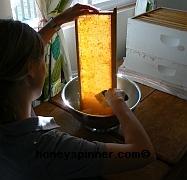
( example of uncapping )
 Honey Extractor
Home |
FAQ
Honey Extractor
Home |
FAQ
What size frames can be used?
The Honey Spinner MINI accepts all standard frames-- both honey super sizes and hive body sizes.
The Honey Spinner ORIGINAL will only accept honey super sizes ( 5 3/8" or 6 1/4" ) inside of the body of the extractor;
however, the ORIGINAL may be used as the MINI if the mandrel assembly is removed from the body of the extractor.
What foundation types can be used?
See "What is "blow-out," and will it occur using a drill to extract the honey?" below.
What kind of drill should be used with the Honey Spinner?
Either a corded or battery-operated drill may be used; the drill must be a variable speed type drill.
A variable speed drill allows the user to control spin speed with gradual trigger pressure;
in other words, gradual depression of the trigger results in a gradual increase in rotational speed.
Thus, the user needs to have some level of comfort using a drill.
It is recommended that you practice gradually increasing speed with the drill prior to coupling the drill to the Honey Spinner so that you understand the operating characteristics of your drill.
Is the axle supported in the Honey Spinner ORIGINAL?
Yes. The axle is supported at the bottom and centered using a part that functions as a plain thrust bearing.
The top of the axle is centered with the crosspiece.
Does extraction occur on both sides of the frames?
Extraction occurs on one side of both frames. Both frames need to be flipped to extract the honey from the sides facing the axle.
Does the Honey Spinner ORIGINAL have a honey gate spigot?
Yes.
What is "blow-out," and will it occur using a drill to extract the honey?
"Blow-out" occurs when the honeycomb flies away from the frame due to centrifugal force during the spinning operation.
All foundation types (unsupported, wire supported and plastic) can be used with the Honey Spinner.
Unsupported/ unreinforced foundation is most at risk for blow-out. Wire supported/ reinforced foundation or plastic foundation is recommended.
Key Points:
1) It is essential that a variable speed drill be used so that the operator can monitor honeycomb response and adjust the speed of rotation.
Gradually ramping up the rotations using the drill trigger is recommended and necessary to determine what speed is appropriate for your frames.
You can stop and start the drill to see if the comb is starting to bulge. If the comb is bulging, you need to slow the rotational speed.
The tendency will be to spin the frames quickly, but self control is required with the drill (especially with unreinforced foundation) to prevent blow-out.
2) You should allow the bees to fully draw out the comb around the frames. Fully drawn comb creates stronger attachment to the frames and reduces risk of blow-out; again, blow-out is more of a risk with unsupported foundation. We use wire reinforced foundation with no issues.
3) High temperature increases the risk of comb failure. Wax strength goes down as temperature goes up. To reduce blow-out risk, frames can be acclimatized in an air-conditioned room.
Can I pick up my order and save s/h?
All orders are shipped. At this time, we do not allow pick-up of orders. We are not set up to receive customers at our facility.
 © |
s@honeyspinner.com |
20 West 1st South, #210, Rexburg, ID, 83440
© |
s@honeyspinner.com |
20 West 1st South, #210, Rexburg, ID, 83440